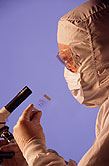
WEDNESDAY, July 23, 2014 (HealthDay News) — Most blood cancer patients in the United States who need a bone marrow transplant can find an acceptable match through the National Marrow Donor Program, a new study has determined.
Depending on a patient’s race or ethnic background, the study found that 66 percent to 97 percent of patients will have a suitably matched and available live donor on the registry.
Even hard-to-match ethnic groups can find a suitable donation thanks to banked stem cells drawn from umbilical cord-blood donations, said senior author Martin Maiers, director of bioinformatics research at the National Marrow Donor Program.
All told, for patients who are candidates for either bone marrow or cord-blood transplants, the likelihood of having a suitable match is as high as 91 to 99 percent, the study found.
“For almost all patients, there is some sort of product available for them,” Maiers said.
The findings, said to represent the first attempt to accurately determine the successful-match rate of the bone marrow registry, are published July 24 in the New England Journal of Medicine.
Patients suffering from blood-related cancers such as leukemia or lymphoma need a stem cell transplant to help them survive their cancer treatment. The transplant is done after chemotherapy and radiation is complete.
Donation from a relative is the best option, but only about 30 percent of patients have such a donor available, researchers said in background notes. The majority must rely on the National Marrow Donor Program to match them with a live bone marrow donor or banked stem cells gathered from donated umbilical cord blood.
The National Marrow Donor Program has on hand 11 million potential bone marrow donors and 193,000 banked cord-blood donations. The number of transplants facilitated by the program has quadrupled, with nearly 6,000 transplants in 2012 compared with 1,500 a decade earlier.
Researchers from the program assessed match rates using genetic data from the bone marrow registry. Models based on U.S. population genetics allowed them to predict the likelihood that a suitable adult donor or banked cord-blood donation could be identified for patients from 21 racial and ethnic groups.
Perfect genetic matches from adult bone marrow donors are available for 75 percent of white patients, but for a much smaller percentage of black and Hispanic patients, the investigators found.
For example, blacks have a 19 percent chance of finding a perfect match through the registry, while Hispanics have a 34 percent likelihood of a match.
But medical science has made it possible for patients to successfully receive a transplant from a bone marrow donor who is closely but not perfectly matched. Using close matches, the likelihood of finding a live donor increases to 97 percent for white patients, 76 percent for black patients and 80 percent for Hispanic patients, the study found.
“Depending on your ethnicity, if you’re a white European, you have a high likelihood of getting a high-degree match,” said Dr. Len Lichtenfeld, deputy chief medical officer for the American Cancer Society. “By the same token, for almost everyone, we will be able to find at least a suitable match. We can help almost everyone.”
Stem cells drawn from umbilical cord blood further widen the field of possible donations, the researchers said. Because stem cells are more flexible, they do not require as precise a match for successful transplantation.
Depending on the ethnic group, the study authors found that between 81 percent to 99 percent of patients will have at least one matched cord-blood unit.
Because a less-than-perfect match is available for everyone, physicians should identify the best available donor from the registry and proceed to transplant rather than wait for a perfect match, Maiers said.
“Transplant early, because the likelihood of the ‘miracle match’ coming through the door while the patient is waiting is very low,” he said.
The data also shows the need to recruit more donors from American ethnic populations, to increase the chances of a suitable and available match, Maiers and Lichtenfeld said.
“Those are clearly areas that can be targeted for increased donation, so we can offer for those communities the same opportunities that are available in the white European community,” Lichtenfeld said.
More information
For more about bone marrow and umbilical cord-blood donations, visit the National Marrow Donor Program.
Copyright © 2025 HealthDay. All rights reserved.

